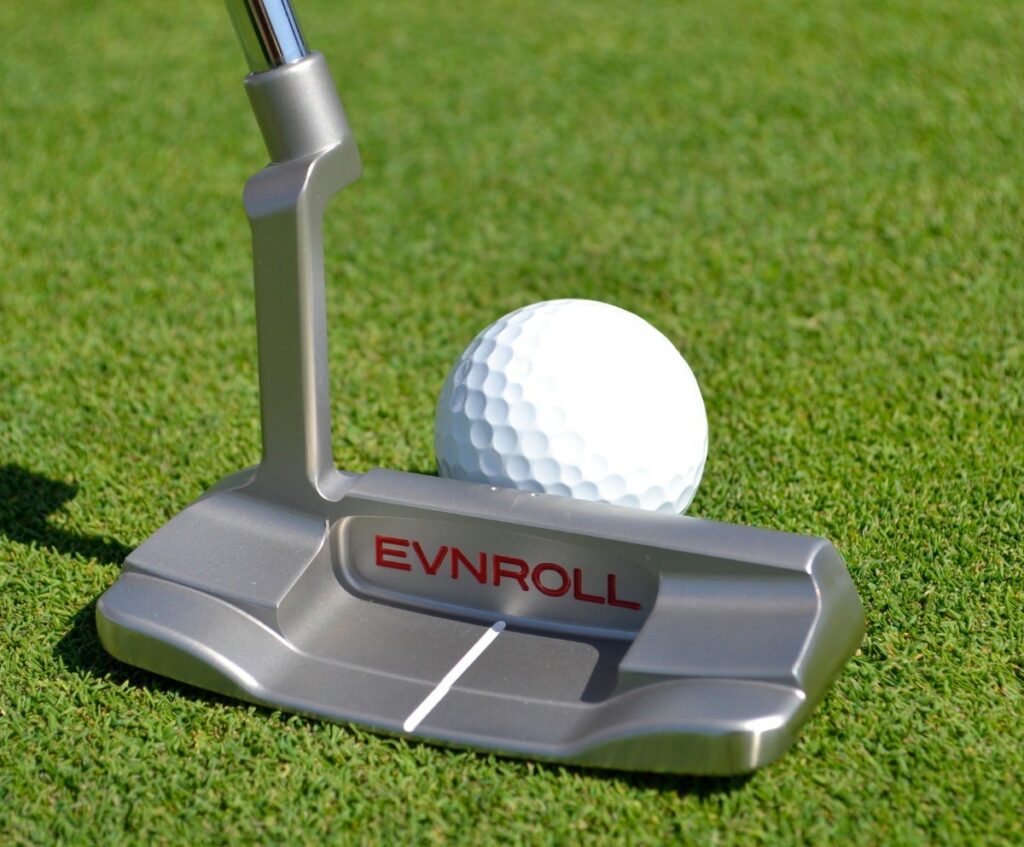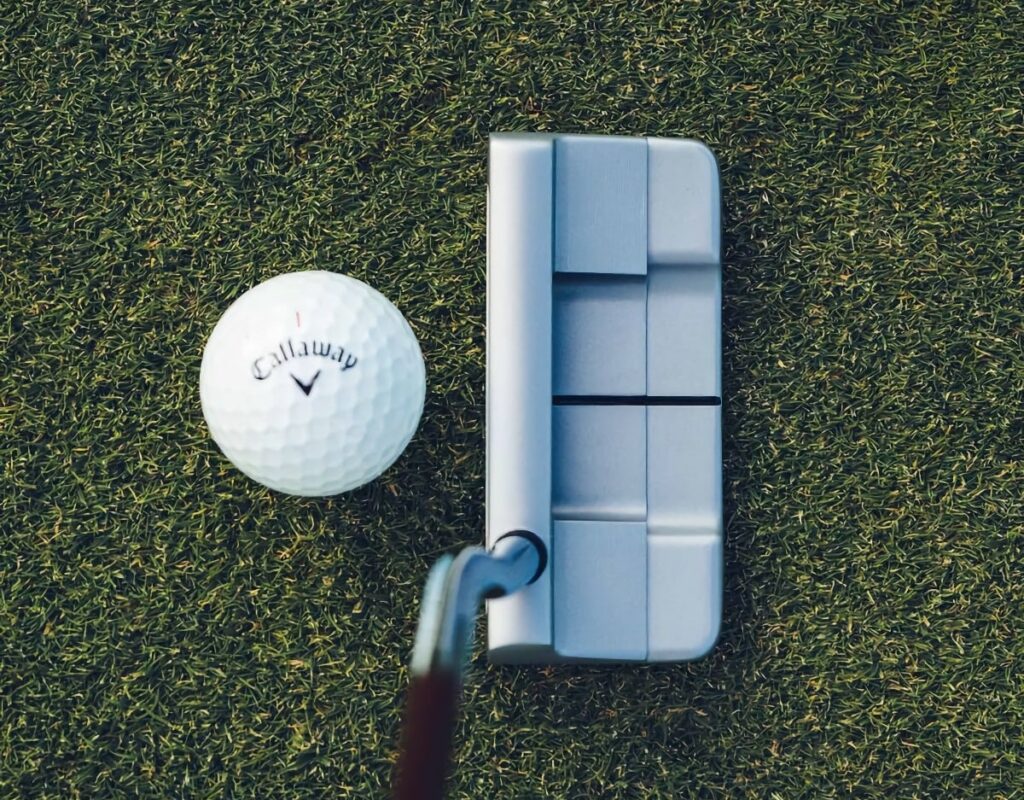For decades, blade putters have dominated the putting greens.
While the invention of mallet putters promised greater forgiveness and stability, many golfers still prefer the feel and aesthetics of a traditional blade-style putter.
For those people, an excellent option to consider is the wide blade putter.
At first glance, you may look at a wide blade putter as a blade with a little extra material behind the face. However, there is more to it than this. The wide blade putter offers some benefits, and it can be a good fit for golfers seeking stability in their strokes.
In this article, I’ll show you the benefits of wide blade putters, how to decide which one is for you, and whether or not this putter can improve your game.
I’m a standard blade person, but after trying a few wide blades — I was impressed!
What Is a Wide Blade Putter?

A wide blade putter has a blade-style head, but with a wider body than a traditional blade putter — similar to a mid-mallet. Simply put, this increases the MOI to provide extra stability and forgiveness. Most wide blade putters are around twice the overall width of a standard blade.
With a wide blade putter, it’s easier to keep the putter head stable at impact.
Many golfers twist or turn the putter face when playing with a traditional blade. The wide blade is a little heavier, offering greater stability and ease of control.
Wide blade putters have higher MOI and more forgiveness than traditional blade putters, making them an excellent choice for golfers that need a little help on the greens.
In recent years, many golfers have become accustomed to mallet putters. While mallet and wide blade putter heads are quite similar from a performance standpoint, mallet putters usually have a deeper and more rounded head shape.
Regular Blade vs Wide Blade Putter

While wide blade putters resemble the regular blade-style head shape they derive from, there are some key differences to be aware of when choosing between the two.
In short, there are three main points of difference:
- Weighting
- Forgiveness
- Alignment
Let’s dive into each of these in some detail!
Weighting
Wide blade putter heads are often a bit heavier than a standard blade style putter, simply because of the extra material used to achieve the wider design.
The heavier weight should not be viewed as a negative. In fact, one of the main reasons that people do not always do well with blade putters is that they can feel too light.
Heavy putters are great on fast greens. You can take a small stroke, tap the ball and get it started on the right line. On slower greens, a light putter can help you swing it enough to feel the ball and get it closer to the hole.
Forgiveness
I find most wide blade putters to be more forgiving than regular blades, because of the additional weight. This results in a higher MOI, and greater stability at impact.
To clarify, MOI is short for Moment of Inertia.
In a discussion with Golf.com, Jonathan Wall of True Spec Golf stated that MOI “is a way to measure a putter head’s resistance to twisting on putts that don’t catch the center of the face. The higher the number, the more stable the putter will be.”
Due to the narrow head shape and lightweight design, high MOI blade putters are pretty hard to come by. Conversely, a high MOI wide blade putter is much easier to find.
Generally, the wide blade putter head will feel incredibly stable through the putting stroke, so you shouldn’t miss the ball left or right of your target too frequently.
Alignment
The wide blade has a deeper head shape. This provides a larger space on the top of the head for manufacturers to provide a long alignment line.
Essentially, a longer alignment line is good for golfers who tend to struggle to main solid contact with the center of the putter face — or align it correctly, to begin with.
Having said that, alignment with a mallet is even easier. But for golfers who prefer the squared-off look of the wide blade putter, it’s a good solution for better alignment.
Regular Blade vs Wide Blade Putter: Summary
| Regular Blade | Wide Blade | |
| Design | Traditional | Traditional |
| Weighting | Lighter | Heavier |
| Forgiveness | Lower | Higher |
| Alignment | Minimal | Greater |
| Stroke Type | Arc | Arc / Straight-back, straight-through |
Ultimately, regular blade putters and wide blade putters have very similar designs.
That said, the wide blade putter will offer greater forgiveness due to the extra head weighting and larger MOI. In addition, the larger space on the top of the head allows for a longer alignment line, which is great for those who struggle with alignment.
Switching between a regular and a wide blade putter will be a seamless transition.
Mid Mallet vs Wide Blade Putter

Typically, mid mallet and wide blade putters have similar head sizes. This means the CG is positioned similarly, and the MOI is relatively high for extra forgiveness in the stroke.
However, there are a couple of key differences to consider:
- Stability
- Top-down look
- Putting stroke
Once again, let’s cover these in some detail.
Stability
In my experience, the large rectangular head shape of the wide blade putter seems to make it feel more stable at impact than a mid-mallet.
That’s not to say that a mid mallet is unforgiving — it’s simply just a little less stable.
As far as overall forgiveness is concerned, when comparing a mid-mallet to a wide blade putter you have to look at the specifics of each individual model.
Often, the stability depends on the position of the center of gravity in the head. This varies slightly between models, so it’s difficult to come to a general conclusion.
As long as the center of gravity is positioned optimally for your putting stroke, forgiveness should be relatively the same across both types.
Top-Down Look
If you like a more modern-looking putter, then you’ll likely prefer the top-down look of a mid mallet. For traditionalists, a wide blade putter has a nice classic look.
The appearance of a putter is essential for us golfers, there’s no two ways about it!
It doesn’t matter if you are a 5 handicap or a 25 — you have to look down and feel good about the putter that you are playing with if you’re to score well on the greens.
Putting Stroke
For players with an arc stroke, the wide blade putter would be best suited. Conversely, mid mallet putters are best for those with a straight-back, straight-through stroke.
Generally, wide blade putters have neck types and toe hang that encourage plenty of face rotation and toe release after contact with the ball.
On the other hand, mid-mallet putters are typically face-balanced. This means they’re better suited to a mechanical back-and-through stroke with minimal rotation.
Mid Mallet vs Wide Blade Putter: Summary
| Mid Mallet | Wide Blade | |
| Design | Modern (generally) | Traditional |
| Stability | Good | Better |
| Alignment | Good | Good |
| Stroke Type | Straight-back, straight-through | Arc / Straight-back, straight-through |
So, mid mallet and wide blade putters have similar performance characteristics.
Having said that, mid mallet putters generally offer a more modern appearance in line with the look you’d expect from mallet putters. Conversely, wide blade putters offer a more traditional blade-like appearance.
Mid mallets are ideal for players with a straight-back, straight-through stroke, while the wide blade putter is better suited to those with an arc putting stroke.

Best Wide Blade Putters
So, we’ve covered everything you need to know about wide blade putters. By this point, you’re probably curious about which models are available on the market today.
Below, you’ll find three of the best wide blade putters to choose from:
Odyssey White Hot OG Double Wide Putter
An Odyssey offering the best of both worlds — a blade crossed with a mallet.
Featuring the brand’s famous White Hot face insert, the Odyssey White Hot OG Double Wide Putter is essentially a blade putter — but with double the width!
And while some wide blade putters suit an arc stroke, this version is face balanced to suit players with minimal arc and face rotation through impact.
Cleveland Huntington Beach Soft #8 OS Putter
This Cleveland putter offers a premium wide-blade design at a budget price.
Simply put, the Cleveland Huntington Beach Soft #8 Putter is a traditional-looking wide blade putter that offers incredible value for money.
With a single bend neck type and a face-balanced head, it’s best suited for those with a straight-back, straight-through putting stroke with minimal face rotation.
Evnroll EV2 Midblade Putter
Sitting at the top end of the spectrum, this Evnroll wide blade putter is a beauty.
Designed with a slant neck and plenty of toe hang, the Evnroll EV2 Midblade Putter encourages an arc stroke with face rotation through contact with the ball.
With a wide body and higher weight profile, the putter feels super stable during the stroke and offers plenty of forgiveness for off-center hits.
Final Thoughts
Putting is a very detail-oriented aspect of golf. Something as simple as the difference between a blade and a wide blade can have a huge impact on your game.
I love the wide blade putters for golfers who are not interested in the larger mallets but still want some increased forgiveness from a more stable clubhead.
Ultimately, I highly recommend you test out a few different models at your local golf shop to see if the extra weight and head size fits your eye — and your stroke.





